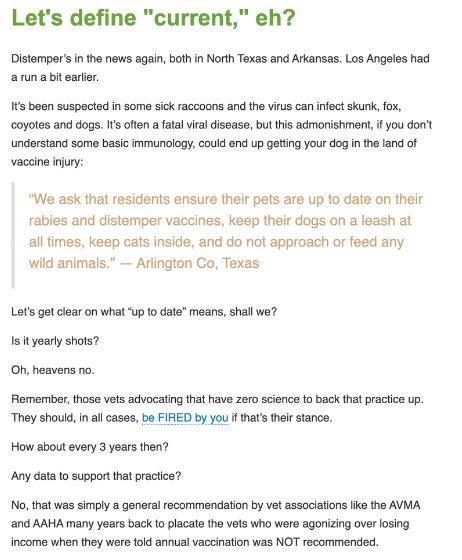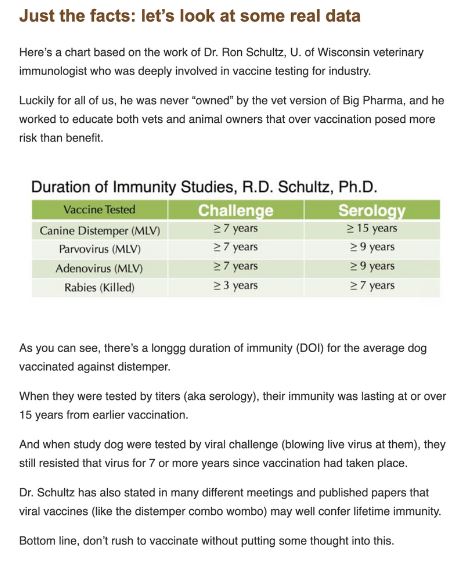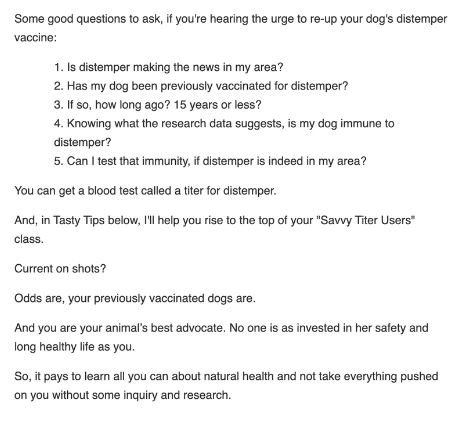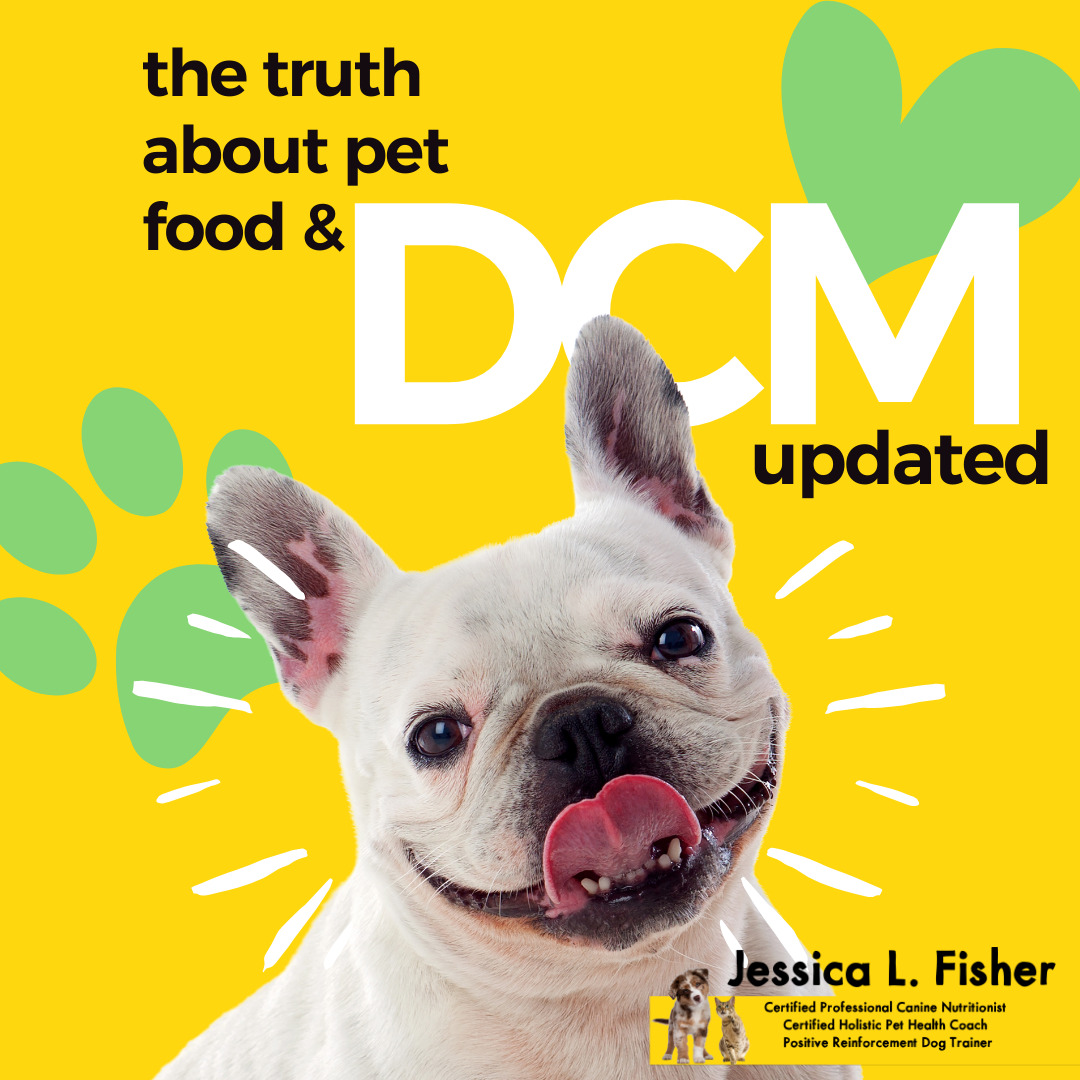I got an email this week from a veterinarian that I follow letting me know that distemper is back in the news, which of course means all the traditional medicine veterinarians are warning clients to get their dog’s vaccines “up to date” once more. That email sparked this post and the corresponding video. I’ll tell you more about what distemper is, what signs to look for, why it’s in the news, what the veterinarian told me about it, and his recommendation.
Canine Distemper
According to the AVMA (American Veterinary Medical Association), “Canine distemper is a contagious and serious disease caused by a virus that attacks the respiratory, gastrointestinal and nervous systems of puppies and dogs. The virus can also be found in wildlife such as foxes, wolves, coyotes, raccoons, skunks, mink, and ferrets and has been reported in lions, tigers, leopards, and other wild cats as well as seals.”
Canine distemper is a respiratory virus, so it is spread from a sick dog (or wild animal) to other dogs around him through sneezing or coughing, though the AVMA also states that exposure from shared food and water bowls is also possible. The virus can also be spread for months in a sick animal and a pregnant animal can spread the virus to her babies through the placenta.
Symptoms
In wildlife, this virus can sometimes look a lot like rabies. In an infected dog, symptoms start relatively mild with watery eyes, or possibly a puss-like discharge from the eyes. From here, the symptoms can range from fever, nasal discharge, coughing, reduced appetite, lethargy, and vomiting.
According to the AVMA, “As the virus attacks the nervous system, infected dogs develop circling behavior, head tilt, muscle twitches, convulsions with jaw chewing movements and salivation (“chewing gum fits”), seizures, and partial or complete paralysis. The virus may also cause the footpads to thicken and harden, leading to its nickname “hard pad disease.”
Canine distemper has no cure and often leads to death.
Treatment consists of supporting the body and combating the symptoms to decrease the chance of secondary infection. These treatments can consist of drugs to control vomiting, diarrhea, and neurological symptoms. A sick dog will also likely receive fluids to keep them hydrated and be separated from other animals to prevent further spreading.
Prevention
In the case of canine distemper, prevention is the best medicine since there is no cure and outcomes are bleak for those affected.
I’ve said many times, and I’ll say it again, I’m not anti-vaccination, I am pro-responsible vaccination. This means that dogs do need to be vaccinated against distemper, or receive canine distemper nosodes in place of vaccination.
You’ve likely never heard of nosodes before, and I’ve never used them, so I can’t tell you more than what I’ve learned from the veterinarian I mentioned above. The article I’ve linked can tell you more about how nosodes could replace vaccination.
It’s also worth mentioning that puppies under 4 months old are at greater risk, since they may not be fully immunized to distemper yet. While you are socializing a young puppy, it is important to keep this in mind and be extra cautious.
This is also a good place to insert Dr. Laurie Coger’s vaccine protocol, as many veterinarians believe, as do I, those small animals receive far too many vaccines all at once and in greater doses than necessary.
Now, let’s talk about distemper being in the news lately.
What you need to know
I follow Dr. Will Falconer, a homeopathic veterinarian, who no longer sees patients, but does educate pet parents on the benefits of alternative medicine. You can read more about him here. While he started out as a traditional medicine vet, he learned that so many animals were becoming ill in the name of the medicine and have for many years now helped others along a more natural path.
This is what I received in my email this week:



It seems that there may be some raccoons in North Texas and Arkansas that are sick with distemper and potentially spreading it to other wildlife. This is a bad thing, as we’ve already established that distemper has no cure and is often fatal in our dogs.
Ok, so what now?
Well, for that, we need to talk about what it means to be “up to date” and why veterinarians use this term. It’s not scientific, that’s for sure. We can test levels of immunity with a positive or negative, meaning yes, your dog has sufficient antibodies to support an immune response to coming into contact with distemper (in this case), or no, your dog does not have sufficient antibodies to provide a sufficient immune response.
What we do know is that vaccinations that provide an immune response, do so for many years, some up to the lifetime of your dog.
We can test this.
I tested Kimberly with what is called a titer test for rabies, distemper, and parvo. She showed sufficient antibodies for all three, so I feel confident that I do not need to poke her again. It makes no sense to do so.
You can also reference a previous post on titer testing and vaccines here.
The news is designed to fear us into reading or watching based on a headline. It’s sad, but it’s true. What I find empowering is to be able to read a headline and see right through it. That’s because I’ve armed myself with knowledge, the same as you’re doing now. I hope this helps you combat the fear and use real data to inform your decisions for both yourself and your pets.
What is your vaccine protocol for your pets? Do you also titer test, or will you consider it now? I hope so.




